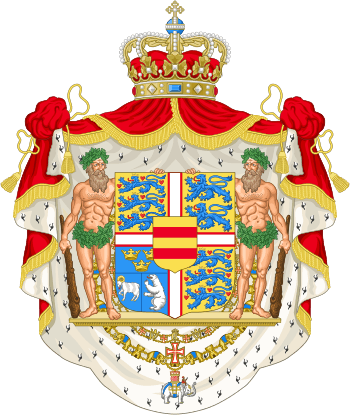Prince Harald of Denmark
Prince Harald of Denmark (Harald Christian Frederik; 8 October 1876 – 30 March 1949) was a member of the Danish Royal Family. He was the third son and fourth child of Frederick VIII of Denmark and his wife, Lovisa of Sweden, and thus brother to Christian X of Denmark and Haakon VII of Norway.
The prince served in the Royal Danish Army for most of his life, and reached the rank of Lieutenant General.
Early life

Prince Harald was born on 8 October 1876 at Charlottenlund Palace north of Copenhagen. His father was Crown Prince Frederick of Denmark (later King Frederick VIII), the eldest son of Christian IX of Denmark and Princess Louise of Hesse-Kassel. His mother was Crown Princess Louise, the only daughter of Charles XV of Sweden and Princess Louise of the Netherlands.
At the age of 17, Prince Harald entered a military career as was customary for princes at the time. He later served with the Guard Hussar Regiment.[1]
Marriage

At the age of 33, on 28 April 1909 at Glücksburg Castle in Schleswig-Holstein, Prince Harald married his second cousin Princess Helena of Schleswig-Holstein-Sonderburg-Glücksburg, daughter of Frederick Ferdinand, Duke of Schleswig-Holstein-Sonderburg-Glücksburg and Princess Karoline Mathilde of Schleswig-Holstein-Sonderburg-Augustenburg.
After their marriage, Prince Harald and Princess Helena lived at the Jægersborghus country house north of Copenhagen which Prince Harald had purchased in 1907.[1] Here their five children were born between 1910 and 1923.
Later life
Like other members of the Danish royal family, his economic situation was influenced by the failure of Den Danske Landmandsbank in 1923. Until 1935, however, he and his family were able to stay at Jægersborghus but then moved to a villa in the northern part of Copenhagen.[1]
At the age of 50, Prince Harald retired from active service with the rank of Major General. In 1933, however, his brother King Christian X appointed him Lieutenant General.
During World War II, Princess Helena became very unpopular because of her sympathy for the German occupation of Denmark and the Nazi party. Because of this, she was reportedly not on speaking terms with her sons.[2]
After the war, Princess Helena was not brought to trial, being a member of the royal family who did not wish any publicity on the matter, but was exiled from Denmark 30 May 1945 and placed under house arrest at the Glücksburg Castle in Germany. She was allowed to return to Denmark in 1947, when Prince Harald fell gravely ill. She stayed with her spouse until his death two years later.[1]
Prince Harald died on 30 March 1949 in Copenhagen. He was buried at Roskilde Cathedral. Princess Helena survived her husband by 13 years and died on 30 June 1962.
Titles, styles, honours and arms
Titles and styles
- 4 March 1887 – 30 March 1949: His Royal Highness Prince Harald of Denmark
Honours
National decorations[3]
- RE – Knight of the Elephant, 28 July 1894
- DM – Cross of Honour of the Order of the Dannebrog, 28 July 1894
- SK – Grand Cross of the Dannebrog, 8 October 1917
- GbET – Commemorative Medal for the Golden Wedding of King Christian IX and Queen Louise
- MM 8 April 1918 – King Christian IX Centenary Medal
Foreign decorations[3]
.svg.png)
.svg.png)
.svg.png)
.svg.png)

- Grand Cross of St. Olav, with Collar
- Commemorative Medal for the Coronation of King Haakon VII and Queen Maud
.svg.png)
- Knight of the Seraphim, 27 August 1897[4]
- Knight of the Order of Charles XIII, 1927[5]


Issue
Harald and Helena had five children:
| Name | Birth | Death | Notes |
|---|---|---|---|
| Princess Feodora | 3 July 1910 | 17 March 1975 | married her first cousin, Prince Christian of Schaumburg-Lippe and had issue. |
| Princess Caroline-Mathilde | 27 April 1912 | 12 December 1995 | married her first cousin Prince Knud of Denmark and had issue. |
| Princess Alexandrine-Louise | 12 December 1914 | 26 April 1962 | married Count Luitpold of Castell-Castell and had issue. |
| Prince Gorm | 24 February 1919 | 26 December 1991 | Unmarried and without issue. |
| Prince Oluf | 10 March 1923 | 19 December 1990 | Lost his title and became HE Count Oluf of Rosenborg after marrying without consent to Annie Helene Dorrit Puggard-Müller and to Lis Wulff-Juergensen. He has issue. |
Ancestry
| Ancestors of Prince Harald of Denmark | |||||||||||||||||||||||||||||||||||||||||||||||||||||||||||||||||||||||||||||||||||||||||||||||||||||||||||||||||||||||||||||||||||||||||||||||||||||||||||||||||||||||||||||||||||||||||||||||||||||||||||||||||||||||||||||||||||||||||||||||||||||||||||||||||||||||||||||||||||||||||
|---|---|---|---|---|---|---|---|---|---|---|---|---|---|---|---|---|---|---|---|---|---|---|---|---|---|---|---|---|---|---|---|---|---|---|---|---|---|---|---|---|---|---|---|---|---|---|---|---|---|---|---|---|---|---|---|---|---|---|---|---|---|---|---|---|---|---|---|---|---|---|---|---|---|---|---|---|---|---|---|---|---|---|---|---|---|---|---|---|---|---|---|---|---|---|---|---|---|---|---|---|---|---|---|---|---|---|---|---|---|---|---|---|---|---|---|---|---|---|---|---|---|---|---|---|---|---|---|---|---|---|---|---|---|---|---|---|---|---|---|---|---|---|---|---|---|---|---|---|---|---|---|---|---|---|---|---|---|---|---|---|---|---|---|---|---|---|---|---|---|---|---|---|---|---|---|---|---|---|---|---|---|---|---|---|---|---|---|---|---|---|---|---|---|---|---|---|---|---|---|---|---|---|---|---|---|---|---|---|---|---|---|---|---|---|---|---|---|---|---|---|---|---|---|---|---|---|---|---|---|---|---|---|---|---|---|---|---|---|---|---|---|---|---|---|---|---|---|---|---|---|---|---|---|---|---|---|---|---|---|---|---|---|---|---|---|---|---|---|---|---|---|---|---|---|---|---|---|---|---|---|---|
| |||||||||||||||||||||||||||||||||||||||||||||||||||||||||||||||||||||||||||||||||||||||||||||||||||||||||||||||||||||||||||||||||||||||||||||||||||||||||||||||||||||||||||||||||||||||||||||||||||||||||||||||||||||||||||||||||||||||||||||||||||||||||||||||||||||||||||||||||||||||||
References
- Bo Bramsen (1992). Huset Glücksborg, 2nd ed (in Danish). Forum. ISBN 87-553-1843-6.
- Tore Pryser (2009). Kvinnliga spioner (Female spies) (in Swedish). ISBN 978-91-27-11741-9.
- Bille-Hansen, A. C.; Holck, Harald, eds. (1943) [1st pub.:1801]. Statshaandbog for Kongeriget Danmark for Aaret 1943 [State Manual of the Kingdom of Denmark for the Year 1943] (PDF). Kongelig Dansk Hof- og Statskalender (in Danish). Copenhagen: J.H. Schultz A.-S. Universitetsbogtrykkeri. pp. 77, 89. Retrieved 30 April 2020 – via da:DIS Danmark.
- Sveriges Statskalender (in Swedish), 2, 1925, p. 813, retrieved 2018-01-06 – via runeberg.org
- Sveriges Statskalender (in Swedish), 2, 1940, p. 345, retrieved 2018-01-06 – via runeberg.org
- "No. 27364". The London Gazette. 11 October 1901. p. 6640.

.svg.png)
